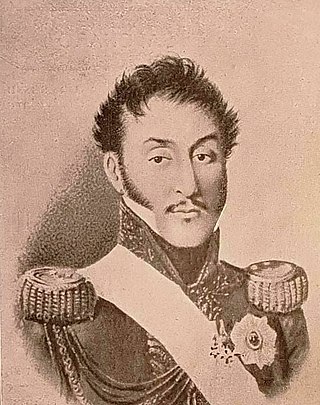
The Hundred Days, also known as the War of the Seventh Coalition, marked the period between Napoleon's return from eleven months of exile on the island of Elba to Paris on 20 March 1815 and the second restoration of King Louis XVIII on 8 July 1815. This period saw the War of the Seventh Coalition, and includes the Waterloo Campaign and the Neapolitan War as well as several other minor campaigns. The phrase les Cent Jours was first used by the prefect of Paris, Gaspard, comte de Chabrol, in his speech welcoming the king back to Paris on 8 July.

Honoré Théodore Maxime Gazan de la Peyrière was a French general who fought in the French Revolutionary Wars and the Napoleonic Wars.

The Battle of Maida, fought on 4 July 1806 was a battle between the British expeditionary force and a French force outside the town of Maida in Calabria, Italy during the Napoleonic Wars. John Stuart led 5,236 Anglo-Sicilian troops to victory over about 5,400 Franco-Italian-Polish troops under the command of French general Jean Reynier, inflicting significant losses while incurring relatively few casualties. Maida is located in the toe of Italy, about 30 kilometres (19 mi) west of Catanzaro.

The Neapolitan War, also known as the Austro-Neapolitan War, was a conflict between the Napoleonic Kingdom of Naples and the Austrian Empire. It started on 15 March 1815, when King Joachim Murat declared war on Austria, and ended on 20 May 1815, with the signing of the Treaty of Casalanza. The war occurred during the Hundred Days between Napoleon's return from exile and before he left Paris to be decisively defeated at the Battle of Waterloo. The war was triggered by a pro-Napoleon uprising in Naples and ended with a decisive Austrian victory at the Battle of Tolentino, after which Bourbon monarch Ferdinand IV was reinstated as King of Naples and Sicily. However, the intervention by Austria caused resentment in Italy, which further spurred on the drive towards Italian unification.

The Battle of the Panaro was a victory for King Joachim Murat's Neapolitan forces over a smaller Austrian force under Frederick Bianchi on 3 April 1815 early in the Neapolitan War. This defeat on the banks on the Panaro River, just south of Modena forced the Austrians to retreat behind the Po River.
The Battle of Carpi took place during the Neapolitan War between a brigade of Neapolitan soldiers under the command of Guglielmo Pepe and an Austrian force under the command of Baron Frimont. The battle took place in the town of Carpi and resulted in an Austrian victory, with the Neapolitans being driven from the town.

The Battle of Casaglia was a part of the Neapolitan War. An Austrian force under the command of Johann Friedrich von Mohr engaged a Neapolitan force under their commander, Joachim Murat. The battle took place around the village of Casaglia, seven miles northwest of Ferrara, and resulted in the Austrians recapturing the village from Murat.
The Battle of Occhiobello was fought on 8 April – 9 April 1815 and was the turning point of the Neapolitan War. Joachim Murat, King of Naples was repulsed by an Austrian force under the command of Johann Frimont whilst trying to cross the bridge over the Po River at Occhiobello. Following the battle, the Austrians would not lose an engagement for the remainder of the war.
The Battle of Ronco took place during the Neapolitan War on 21 April 1815 in the village of Ronco, just south of Forlì. The main Neapolitan army, retreating following the disaster at the Battle of Occhiobello, was being pursued by an Austrian corps under the command of Adam Albert von Neipperg. The Neapolitans, commanded by their king, Joachim Murat, turned to check the Austrians at the Ronco River. The Neapolitans rear guard was defeated by a smaller advanced Austrian force, compelling Murat to retreat further south to the Savio River. The Austrians suffered light casualties, whereas nearly 1,000 Neapolitans were killed or wounded and more deserted Murat altogether.

The Battle of Pesaro was a minor battle in the Neapolitan War that took place on 28 April 1815 in the town of Pesaro.

The Battle of Castel di Sangro was a minor battle in the Neapolitan War that took place on 13 May 1815 in the town of Castel di Sangro in central Italy. The battle resulted in the Neapolitan force being routed.

The Battle of San Germano was the final battle in the Neapolitan War between an Austrian force commanded by Laval Nugent von Westmeath and the King of Naples, Joachim Murat. The battle started on 15 May 1815 and ended on 17 May, after the remaining Neapolitan force was routed at Mignano.

The siege of Ancona took place during the Neapolitan War. It took place beginning on 5 May 1815 and persisted until 30 May 1815. The battle took place mere days after the Battle of Tolentino on 3 May 1815.

François Xavier de Schwarz or François-Xavier-Nicolas Schwartz was born in Baden but joined the French army in 1776. He became a cavalry officer during the French Revolutionary Wars, fighting with the 2nd Hussar Regiment in numerous actions including Jemappes, Fleurus, and Neuwied. After being captured in an abortive invasion of Ireland, he was promoted to command the 5th Hussar Regiment. He led the unit in the War of the Second Coalition, most notably at Hohenlinden and in the subsequent pursuit of the Austrians.
Gaspard Amédée Gardanne was a French general who fought in the Napoleonic Wars.

The Battle of Wörgl or Wörgel was fought on 13 May 1809, when a Bavarian force under French Marshal François Joseph Lefebvre attacked an Austrian Empire detachment commanded by Johann Gabriel Chasteler de Courcelles. The Bavarians severely defeated Chasteler's soldiers in series of actions in the Austrian towns of Wörgl, Söll, and Rattenberg. Wörgl is located 20 kilometres (12 mi) south of the modern-day German border on the upper Inn River.

The Battle of Faenza, also known as the Battle of Castel Bolognese on February 3, 1797, saw a 7,000 troops from the Papal Army commanded by Michelangelo Alessandro Colli-Marchi facing 9,000 troops from the French Army under the command of Claude Victor-Perrin. The veteran French troops quickly overran the Papal army, inflicting disproportionate casualties. The town of Castel Bolognese was located on the banks of the Senio River 40 kilometres (25 mi) southeast of Bologna, and the city of Faenza was also nearby. The action took place during the War of the First Coalition, as part of the French Revolutionary Wars.

The siege of Condé saw a force made up of Habsburg Austrians and French Royalists commanded by Duke Ferdinand Frederick Augustus of Württemberg lay siege to a Republican French garrison led by Jean Nestor de Chancel. After a blockade lasting about three months the French surrendered the fortress. The operation took place during the War of the First Coalition, part of a larger conflict known as the French Revolutionary Wars. Condé-sur-l'Escaut, France is located near the Belgium border about 14 kilometres (9 mi) northeast of Valenciennes.

The Army of the Kingdom of Naples was the land force of the Kingdom of Naples. It was in service from 1806 to 1815, reborn from the Army of the Two Sicilies after the French invasion of Naples. It served alongside Napoleon’s Grande Armée in various campaigns of the Napoleonic Wars, until its final demise in the Neapolitan War.

The 1st Regiment of the Line (King's Own) or (Italian: 1° Reggimento della Linea 'del Re') was a line infantry regiment of the Royal Army of Naples. The regiment was the first infantry regiment formed by the small kingdom, but by 1811 gained a reputation as an exemplary infantry regiment, and was reformed with the honorary title of "King's Own, or del Re". After the disastrous Neapolitan War, the regiment was disbanded, having never seen action outside of the Napoleonic Wars.
















